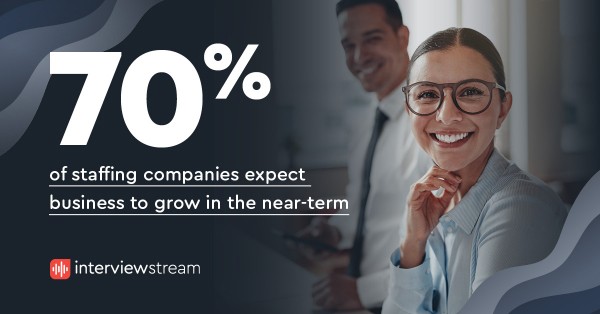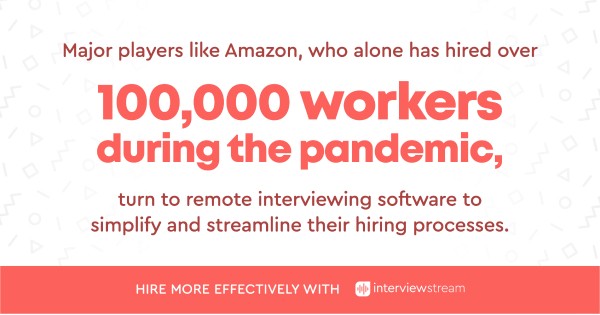2021 Workforce Projections for Every Industry

The rundown
- Attracting and retaining talent is only getting harder – but it’s easier if you get the right hiring process and tech in place
- The war on talent is even more competitive in a remote world and a unique interviewing experience will give you a competitive edge with top talent
- HR tech has become front and center due to changes in workforce and the hiring landscape
- Hiring effectiveness is now more important than ever
- 2021 is the year of employment recovery across a lot of industries, but not all
Table of contents
- 2021 overview
- K12 education
- Higher education
- Finance
- Staffing and recruiting
- Government
- Healthcare
- Insurance
- Manufacturing
- Retail
- Technology
- Final thoughts
- About interviewstream
2021 overview
No one could have anticipated the events of the past year, nor the speed and scope at which our world would suddenly change.
COVID-19 has accelerated business strategies by a global average of 6 years. A survey of 800 executives around the world found that 75% of companies were unprepared to handle an emergency of the pandemic’s scale, at least initially. That said, 66% of executives have completed initiatives this year that previously encountered resistance.
What does that mean for the future?
We don’t have a crystal ball, but if vaccines roll out as anticipated and the presidential transition of power runs smoothly, here are our workforce projections for several major industries in 2021.
K12 education
6.9% fewer public school teachers are employed than this time last year. A majority of those positions weren’t laid-off – they were left vacant after many teachers were prompted to retire early or leave their jobs completely due to the pandemic.
Beyond that, most states project significant revenue shortfalls for 2021, a threat to the aid that education needs. Budget concerns are amplified further as schools are also faced with purchasing costly necessities related to coronavirus, like technology and PPE.
Projection: We anticipate an increase in the demand for full-time and substitute teachers, and for the teacher employment gap to grow as a result. With budgets being pulled in different directions, this will force districts to get creative with how they’re recruiting talent.
Interested in our HR newsletter? Sign up below!
Sign up for our newsletter – we send out a newsletter email two to four times a year which includes HR trends, industry-relevant knowledge, and the latest interviewing tips for recruiters and candidates.
Higher education
82% of college and university presidents anticipated hiring freezes at some point in the 2020-2021 school year. This was likely because undergraduate enrollment fell by 9.4% year-over-year. By the end of 2020 alone, public colleges and universities saw an average employment drop of 13.7%.
Projection: In 2021, this downward trend will continue as expense cuts carry over into the new year, meaning reduced staff, supplies, and capital across the board. Also, until campuses allow students to return, we believe that undergraduate enrollment will only fall further which is likely to either pause hiring or increase colleges’ dependencies on temporary staff.
Finance
Nearly $40B worth of deals were announced in November as executives used cheap debt or cash to carry out mergers and acquisitions. At the same time, 50% of managers shared that they have employees who are facing burnout from heavy workloads, causing 8 in 10 to be worried about losing valuable employees.
Projection: The competition for financial talent is likely to become even more fierce. Going into the new year, 79% of organizations believe they’ll offer bonuses to accounting and finance professionals to attract top candidates. Beyond budgeting accordingly, leaders will need to leverage hiring tools to reach talent more quickly than their competitors and save on their bottom line.
Staffing and Recruiting
Year-over-year market size decreased by 21%:
- 2019 – $152M
- 2020 – $119M
Luckily, it seems the industry is about to round a corner – 70% of staffing companies expect business to grow in the near-term as employers begin to hire again.
Projection: We predict that remote work will remain commonplace across the country. Out-of-state hiring is going to become the norm, significantly broadening the talent pool for hiring professionals. On top of that, as the economy recovers, more and more businesses will require help hiring back employees and even teams.

Source: “Infographic: How the Pandemic is Disrupting the Staffing & Recruiting Industry“
Government
The Departments of State and Labor respectively employ about 12% fewer workers than they did prior to Trump’s presidency. This is in part due to a State hiring freeze of 16 months that has had a deep and widespread impact on the department. Further, government payrolls recently declined by 99,000 jobs as temporary Census workers left.
Once sworn in this January, President-elect Biden plans to add more roles in nearly every department, stating his administration will “depend on a fully functioning civil service.” His team intends to rebuild the federal workforce, according to several individuals involved in the effort, though we likely won’t see the extent of that impact through mid-year.
Projection: By the end of January, thousands of government positions will be open and ready to be filled. In order to fill, train, and onboard that many roles, hiring teams will have to operate at full capacity and screen hundreds of candidates in a few short weeks or months.
Healthcare
While the healthcare industry initially faced layoffs and furloughs for non-essential workers, that loss was just a fraction of the number projected to be employed this decade. In late November alone, healthcare added 46,000 jobs to the economy. Of the 10 fastest-growing jobs in the U.S. today, 6 are in healthcare. The industry is expected to grow more than any other industry over the next 10 years.
Projection: The healthcare industry won’t have enough talent to fill its ever-growing demand. Soon, hospitals and healthcare organizations are going to have to deploy alternate educational options that teach the skills necessary to work in the field, without the costs associated with higher education. Even then, vying for talent will remain cutthroat, with salaries for sought-after positions skyrocketing by mid-year.
Source: “From the Frontlines of Hiring in Healthcare Today — Fireside Chat Recap“
Insurance
In 2020, the insurance market was volatile – on top of the pandemic, hurricanes and wildfires have caused devastation across the country. Fortunately, the industry is on the path to recovery… If it can find the right talent in the new year. The average insurance agent is 56 while the national average age of retirement is only 63-65. In 2020, 40% of the industry was eligible to retire, a figure that will only grow in the new year.
Projection: Come 2021, most insurers will be shifting their recruiting and hiring efforts to target and uncover rising talent. For instance, 90% of execs have a long-term plan to implement tech so they can attract up-and-coming candidates to their org.
Manufacturing
Following the pandemic-driven shutdowns in early 2020, manufacturing saw a steep decline through April. The industry slowly rebuilt throughout the year, with industrial production and factory orders gradually returning the normal. That said, employment levels remain more than 600,000 workers lower than the beginning of the year. As a result, 89% of manufacturers are leaving jobs unfilled because they can’t find qualified applicants.
Projection: This year, finding talent will be one of the largest challenges faced by industry leaders. Already, 72% of execs plan to increase spending on hiring technicians in the first few months of 2021. Whether by increasing compensation, slimming margins, or investing in hiring tech, the other 28% need to allocate their budget accordingly to stay in the running for candidates.

Source: “Infographic: The Pandemic’s Impact on the Manufacturing Industry“
Retail
Pre-pandemic, 85% of purchases occurred in-store, but by the end of the year, an estimated ~25K retail stores will have closed for good. Up to 60% of those closures are mall-based, including brands like Nordstrom, JCPenney, and Bed Bath and Beyond. On the flipside, it was a banner year for online retailers, with $189 billion spent during the holiday season alone (up 33% from 2019).
Projection: Retailers must invest in hybrid shopping experiences to stay competitive in 2021. By combining in-person and eCommerce options, businesses will be able to reach a larger audience, more effectively than they’ve been able to with past traditional models. This also means that retailers will have to refocus their hiring efforts to rely more heavily on a contingent workforce than years past for optimal scalability.

Source: “Infographic: The Pandemic’s Impact on the Retail Industry“
Technology
Last year, demand for engineers and developers grew by more than 30%. Today, one-third of all tech job openings are for software developers. 80% of leaders are struggling to find the right technical talent. 25% of overall hiring will be for new-age digital skills such as:
- Artificial intelligence
- Machine learning
- Data engineering
- Robotic process automation
Projection: Demand for tech and IT professionals will continue to grow in 2021, expanding the already-wide skills gap. By 2028, 21% more developers will be required to meet organizational needs. Starting next year, we predict that upskilling programs will quickly rise in popularity and companies will begin seeking high-potential talent that can hone up-and-coming skills over the following years.
Final thoughts
Though nearly 12 million Americans are currently unemployed, as businesses rebuild and industries flourish, close to 70% of organizations that have furloughed or laid off employees during the pandemic plan to rehire those staff members in the coming months.
As we transition into (hopefully) the final chapters of the COVID-19 pandemic, we look to the future with optimism. We hope the joy of this year cancels out the strife of 2020 ten-fold. May 2021 be your most rewarding year yet!
About interviewstream
interviewstream is an industry leading recruiting software company that helps you reach your top candidates more effectively. Our customers have completed over 3 million interviews using interview builder, interview on demand, interview scheduler, interview connect – and we’d love to help you as well. Talk to an expert today to learn how to get started.
The interviewstream platform
Speak to an expert today to learn how our remote interviewing solutions make hiring more effective.
About interviewstream
As companies transition to remote work, we exists to help recruiters and hiring teams ask the right questions every time, screen candidates faster, make scheduling easier and reach candidates everywhere. Using our remote interviewing platform, your team will have a complete view of the candidate in one location while also leveraging one of the leading platforms for online interviewing.



